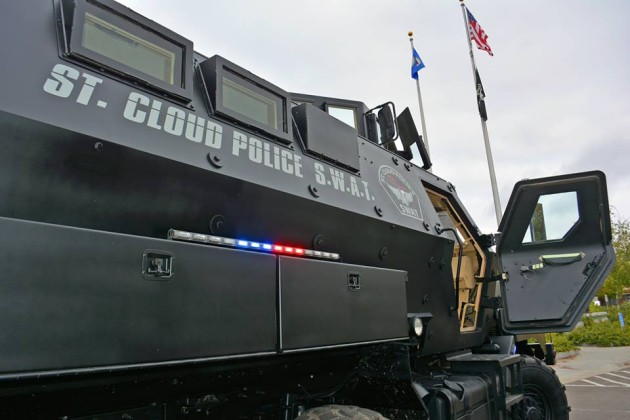When the big one hits St. Cloud, the police department will be ready.
The city’s police force unveiled its new SWAT team vehicle today. Here’s a picture supplied by radio station KNSI on its Facebook page.

Seven police departments — mostly sheriff’s departments — in Minnesota got trucks just like this thanks to money from the Department of Homeland Security. The St. Cloud Times says the city only had to pay the $3,000 cost for getting it from Kansas.
Hennepin County unveiled its SWAT truck last spring. It cost $400,000, according to KARE. It’s intended for executing “high-risk warrants, barricaded individuals, or hostage situations.”
With the “free” money in the form of grants, there’s nothing to discourage police departments from stocking up on military-style vehicles.
Last year, the relatively small — and certainly idyllic — town of Keene, New Hampshire opted to accept the $300,000 it cost to add one to its police department. But that sparked a rift in town with many residents who complained it perpetuates a “culture of war” in the country.
In its application for the grant, according to an editorial in August in the Keene Sun Sentinel, police cited the large number of people who attend the city’s pumpkin festival in its rationale for the vehicle.
In a memo last month, the Keene police wrote the city’s BearCat had been used 21 times from November to June, mainly for training (presumably training in how to use a BearCat). It was used twice in situations involving suicidal persons.
That’s a pretty small sample size, but it does further a point made in these pages and elsewhere 18 months ago, when the Keene City Council was revisiting its vote to accept the BearCat grant: Those in favor of such expenditures must adequately demonstrate the genuine need for such a vehicle, not simply the theoretical danger posed by any large gathering of people.
Further, the federal government should be keeping a tighter rein on its purse strings rather than let fear be the sole justification for arming police with such tactical weapons as tanks and sno-cones.
But the city council approved the “purchase” anyway.
In that state’s capital — Concord — late this summer, protesters initially stopped the police chief from buying the vehicle, according to The Atlantic.
Then again, no town in the United States should theoretically require such weapons, yet cities of every size have them thanks to the Pentagon’s congressionally approved “1033 Program.” Begun in 1994, the program allows the Department of Defense to donate weapons, vehicles, and equipment to local police departments, regardless of whether they need them (or know how to appropriately use them).
Last year, Concord Police Chief John Duval decided he wanted what other cities have. In Concord’s grant application to the Department of Homeland Security, obtained by the New Hampshire Civil Liberties Union, Duval and the city practically had to make up a threat, claiming that while New Hampshire has “not been victimized from a mass casualty event from an international terrorism strike however on the domestic front, the threat is real and here. Groups such as the Sovereign Citizens, Free Staters and Occupy New Hampshire are active and present daily challenges.” After the grant application was unearthed by the NHCLU, Duval “said he does not see the groups as domestic terrorists and admitted that the section of the application was poorly worded.”
But the city council relented there, too, and “purchased” the vehicle, which has made the SWAT vehicle purchase one of the primary issues in city elections.
